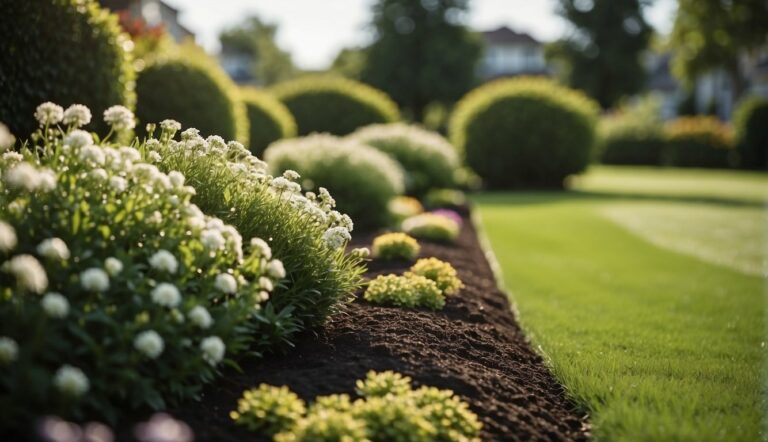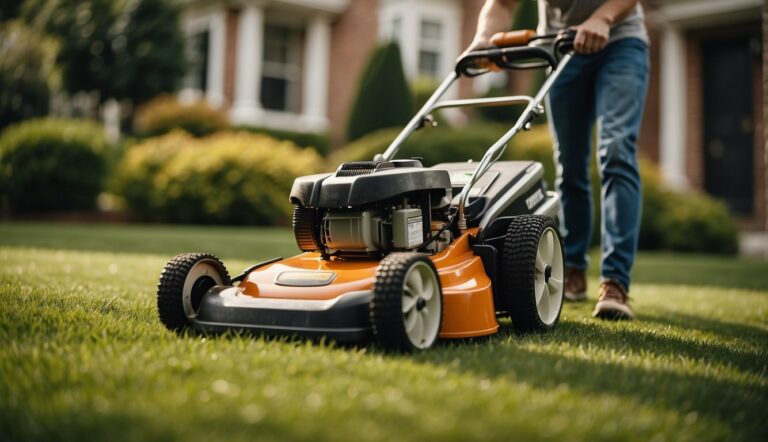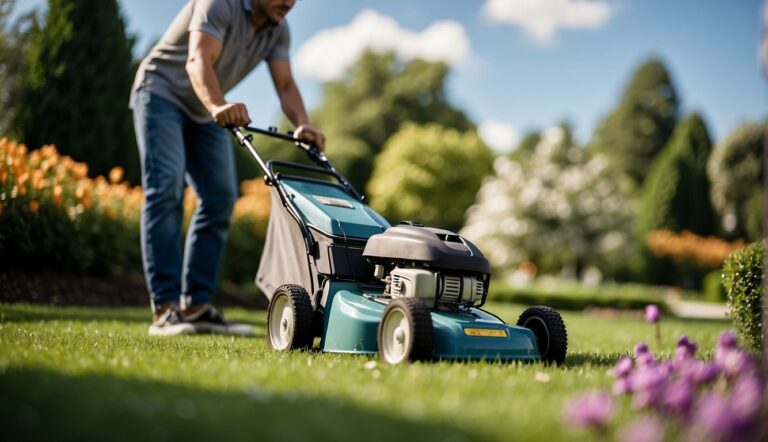Sod installation is the cornerstone of a lush, vibrant lawn that enhances the beauty of any landscape. At our locally-owned landscaping company, we understand the impact a professionally installed lawn has on the overall aesthetic and value of a property. With years of hands-on experience in the field, we’ve mastered the art of sod installation, tailoring our approach to suit the unique needs of each landscape we encounter.
As seasoned professionals in the landscaping industry, we take pride in our precision and attention to detail. Our process includes thorough soil preparation, ensuring optimal conditions for sod to take root and thrive. We believe in providing practical, straightforward advice to our clients, enabling them to maintain their lawns with ease long after our work is done.
Our team is committed to delivering top-tier service, executing each sod installation project with care and professionalism. We equip our clients with the knowledge necessary to sustain the health and vitality of their lawns, regarding sod installation as more than just a service – it’s a partnership in creating a lasting landscape you can be proud of.
Sod Installation
When we install sod, we’re not just laying grass; we’re creating the foundation for a vibrant lawn. Selecting the right type of sod and assessing soil conditions are crucial first steps, followed by choosing the optimal season for installation to ensure your landscape flourishes.
Types of Sod and Grass Selection
As experienced landscapers, we understand that choosing the right type of sod depends on the yard’s climate and region. Here’s a breakdown to guide your selection:
- Warm-Season Grasses: Ideal for southern regions with hot summers. Examples include Bermuda, Zoysia, and St. Augustine.
- Cool-Season Grasses: Best for northern areas with cooler summers. Think Kentucky Bluegrass, Fescue, and Ryegrass.
Assessing Soil Conditions for Sod
Before laying sod, assessing soil conditions is paramount for successful lawn establishment. Soil should be:
- Loose and Rich: This allows roots to penetrate deeply and easily.
- Well-Draining: To prevent waterlogging which could damage the sod.
We usually conduct a soil test to tailor soil amendments and ensure the ground is ready to support your new grass.
Optimal Season for Installation
Timing matters. Install sod during your region’s moderate growing season—this ensures:
- Warm-Season Grasses: Late spring to early summer is perfect when temperatures are consistently warm.
- Cool-Season Grasses: Early spring or early fall when temperatures are cooler yet still encourage growth.
Let us use our professional experience to create a thriving landscape for your home.
The Sod Installation Process
Our extensive experience in professional landscaping equips us to handle your sod installation project with expertise. We ensure a seamless transition to a lush lawn through meticulous soil preparation, precise sod laying, and dedicated post-installation care.
Preparing the Landscape
Before we lay sod, it’s crucial to create a receptive environment for it. Firstly, we remove all debris, including old grass and weeds, to prevent any growth hindrance. Proper soil preparation involves leveling and grading the landscape to ensure efficient water drainage. Our team also conducts a soil test to determine the need for amendments such as fertilizers that enrich the soil with essential nutrients.
- Remove debris: Clear the area of old grass, weeds, and rocks.
- Soil testing: Test to determine pH and nutrient levels.
- Level and grade: Even out the ground to prevent water pooling.
Laying the Sod
Laying sod requires a strategy that starts with moistening the soil to provide a welcoming bed for the new grass. We carefully lay sod strips against a straight edge like a driveway, ensuring there are no gaps or overlaps. Staggering the joints in a brick-like pattern, we cover the area efficiently. Our expertise in sod installation includes detailing about irrigation systems, such as placing the sprinkler heads at appropriate locations.
- Soil moisture: Water the soil thoroughly but not until saturated.
- Sod placement: Lay the first row against a straight edge, no gaps or overlaps.
- Pattern: Stagger joints in a brick-like pattern for uniform growth.
Post-Installation Care
After installation, we actively guide you on caring for your new sod. Watering is crucial; we advise you on the appropriate watering schedule to prevent drying or oversaturation. The first mow should occur once the sod is rooted, typically two weeks post-installation. Following our specific care plan, including when to reintroduce fertilizer, ensures your lawn remains healthy and robust.
- Watering: Keep the sod moist, adjusting for weather and soil conditions.
- Mowing: Wait until sod is rooted before the first mow.
- Maintaining: Follow our care plan for watering, mowing, and fertilizing schedules.
Costs and Budgeting for Sod Installation

We understand that budgeting for a new lawn involves careful consideration of various costs associated with sod installation. We’ll help guide you through understanding sod pricing, the factors that can affect the overall cost, and how to effectively get and compare quotes to ensure you make an informed decision for your landscaping investment.
Understanding Sod Pricing
Cost Per Square Foot: Sod cost typically ranges from $1.00 to $2.00 per square foot for the materials alone.
Labor and Preparation: Expect to pay about $0.50 to $1.00 per square foot for installation labor. This can vary based on site accessibility and other factors.
Example Calculation:
For a 500 square foot area:
- Sod Material: $1.00/sq ft x 500 sq ft = $500
- Installation: $0.75/sq ft x 500 sq ft = $375
- Total Estimate: $875
Note: These are average costs; actual costs may vary.
Factors Affecting Installation Costs
Site Preparation: Costs can increase if extensive site prep is needed due to poor soil conditions or existing lawn removal.
Accessibility: Hard-to-reach areas may require additional labor, thus increasing the price.
Type of Sod: Different sod varieties come at different price points. Premium sod varieties will be more costly.
Quantity: Larger areas often reduce the cost per square foot due to economies of scale.
Use this list to assess your unique situation and begin to budget for your project.
Getting and Comparing Quotes
Gather Multiple Quotes: Reach out to us and other local landscaping companies for a range of estimates.
Itemized Quotes: Ensure that quotes are detailed, breaking down costs by material, labor, delivery, and any additional services.
A quick tip:
- Compare quotes not only for price but also for the detail and transparency they provide.
- Remember, the cheapest quote may not always be the best option in terms of quality and reliability.
Our goal is to ensure you receive the best value for your sod installation services, and we are confident in our ability to provide you with a lush, green lawn that complements your home and fits within your budget.
Choosing the Right Sod Installation Company
When hiring for sod installation, it’s crucial to choose a professional company that delivers exceptional customer service and has a robust track record. We understand this need firsthand, for we own and operate a landscaping services company committed to quality and customer satisfaction.
Evaluating Professional Landscapers
We advise considering a company’s past performance and area of expertise. A company like The Grounds Guys, known for their sod installation expertise, is a prime example of a professional service to consider. When evaluating options, contact each company for an initial consultation to gauge their willingness and ability to meet specific landscaping needs.
Licenses and Credentials
Always verify that a company holds the required licenses. This is not only a mark of legitimacy but ensures adherence to local regulations. A licensed company means they are accountable and have met professional standards. Make sure to ask for their license number and validate it with local authorities if necessary.
Key Credentials to Check:
- Business License: Confirm they are legally recognized to operate in your region.
- Certifications: Look for relevant industry certifications that underscore their expertise.
Customer Reviews and Reputation
Lastly, analyzing reviews and assessing the company’s reputation is essential. Look for a pattern of positive feedback and pay attention to how the company responds to any customer service issues. Real customer experiences offer valuable insight into what you can expect.
| Source | Average Rating | Response to Reviews |
|---|---|---|
| 4.5 Stars | Prompt and positive | |
| Yelp | 4 Stars | Engaged and helpful |
Remember, your goal is to ensure the best sod installation services, and the right company will make a significant difference.
Maintaining Your New Lawn
A healthy lawn is not only about good looks; it’s a commitment. As seasoned experts in landscaping, we’ve crafted a regimen to keep your lawn lush and vibrant.
Regular Lawn Maintenance Tips
Performing regular maintenance is essential for the health and appearance of your new sod lawn. We recommend:
- Mowing: Keep your lawn around 30-60 mm in height. Never cut more than 1/3 of the grass blade at once to avoid stress.
- Aeration: Annual aeration helps nutrients penetrate the soil, promoting root growth.
- Thatch Control: Remove thatch if it exceeds 1/2 inch to ensure water and nutrients reach the soil.
Irrigation and Fertilization Schedule
Water and nutrients are pivotal for a thriving sod lawn. For effective irrigation and fertilization, observe the following guidelines:
Watering:
- Weeks 1-2: Water twice daily, ensuring the sod stays moist.
- Weeks 3-8: Gradually reduce watering to once every 2-3 days.
- Thereafter: Water as needed, typically 1 inch per week.
Fertilization:
- First feed: Approximately 6 weeks after installation.
- Routine feeds: Follow with seasonal fertilizer applications.
Dealing with Weeds and Pests
Weeds and pests can hinder lawn growth. Here’s our approach:
- Weed Control: Begin weed control methods only after the lawn is established, usually 4-6 weeks post-installation.
- Pest Management: Regularly inspect for signs of pest damage and use targeted treatments as necessary.
Through our consistent care, your new sod lawn will remain robust and healthy.





